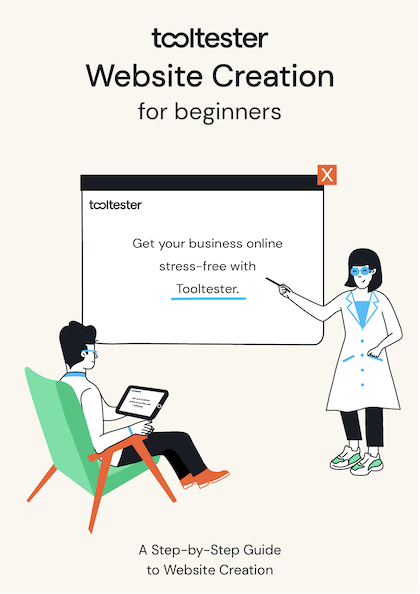Tooltester is supported by readers like yourself. We may earn an affiliate commission when you purchase through our links, which enables us to offer our research for free.
Ready to turn your passion for photography into more than just a side hustle?
Or, maybe you’ve outgrown your Instagram gallery, and are ready for a more professional-looking online presence.
Whatever your reason for seeking out the best website builder for photographers, the great news is that there are plenty of excellent options to choose from.
In fact, you could argue there are too many. Between fully-kitted content management systems like WordPress, and more specialized photography website builders like Pixpa, you might shutter at the thought of narrowing it down to just one.
(Yes, it took me a while to come up with that. No, there won’t be any more photography-related puns in this article. Promise.)
With the help of professional photographers who have been through the process, we’ve put together this guide to help you select the right photography website builder for your needs.
You’ll learn:
- Which photography website builders best support client galleries, proofing features, and selling online
- Which options provide the most eye-catching responsive website designs
- Which are the easiest to use
- Which offer the best value for money
Sidenote: since many photographers are also into filming, I just wanted to make sure you know that we also have an article on the best website builders for videographers.
So, let’s get straight into it!
The 6 best website builders for photographers
A photography website requires some niche features (see our table below), so with all these in mind, here’s our pick for the top website builders for photographers:
- Wix – The website builder with it all
- Squarespace – The website builder for creatives
- WordPress – The website builder with no limitations
- Pixpa – The affordable, all-in-one photography website builder
- Format – The website builder for running a photography business
- SmugMug – The website builder for selling your photography
You can also learn more about our top picks for making a photography portfolio in the following video:
The best website builders for photographers: Summary of features
| Wix | Squarespace | WordPress | Pixpa | Format | SmugMug | |
|---|---|---|---|---|---|---|
| Photography templates | ✓ | ✓ | ✓ | ✓ | ✓ | ✓ |
| Portfolios | ✓ | ✓ | ✓ | ✓ | ✓ | ✓ |
| Appointment booking | ✓ | ✓ | ✓ (via plugin) | ✓ (through BookingBug widget) | X | X |
| Private client galleries | ✓ | ✓ | ✓ (can be enabled through plugins like Picu) | ✓ | ✓ | ✓ |
| Client proofing features (comments, favorites etc) | ✓ | X | ✓ (can be enabled through plugins like Picu) | ✓ | ✓ | ✓ |
| Sell digital and physical products (generic) | ✓ | ✓ | ✓ (via WooCommerce, Ecwid, or other ecommerce plugins) | ✓ | ✓ | ✓ |
| Sell client prints (through print lab fulfillment) | ✓ | X | ✓ (via plugin) | ✓ | X | ✓ |
| Custom domain | Free for 1st year with annual Premium subscription | Free for 1st year with annual subscription | Free for 1st year with annual WordPress.com subscription | Free for 1st year with annual subscription (excluding Basic plan). Via hover.com | Free for 1st year with annual subscription (excluding Free and Basic plans) | No free offers but you can purchase or connect your own |
| Pricing | A free plan is available. Paid plans start at $17 / month | From $16 / month | WordPress.com offers a free plan, with paid plans starting $4 / month.
A self-hosted WordPress site starts around $6 / month |
From $6 / month | A free plan is available, with paid plans starting at $7 / month | From $16 / month |
| Get started | Try Wix for free | Try Squarespace for free | Try WordPress (with Dreamhost) | Try Pixpa for free | Try Format for free | Try SmugMug for free |
1. Wix – The website builder with it all

Wix is one of those rare website builders that not only does everything – it also happens to do it exceptionally well. In addition to catering to small businesses, bloggers, and online store owners, it also offers creatives – including photographers – a comprehensive toolkit to help them establish an online presence.
Aside from its wide range of modern-looking templates, Wix offers a robust store builder, online booking features, and various business and marketing tools (which we go into more detail below).
There are also photography-specific features such as portfolio pages, image galleries, private albums, and print-on-demand integrations.
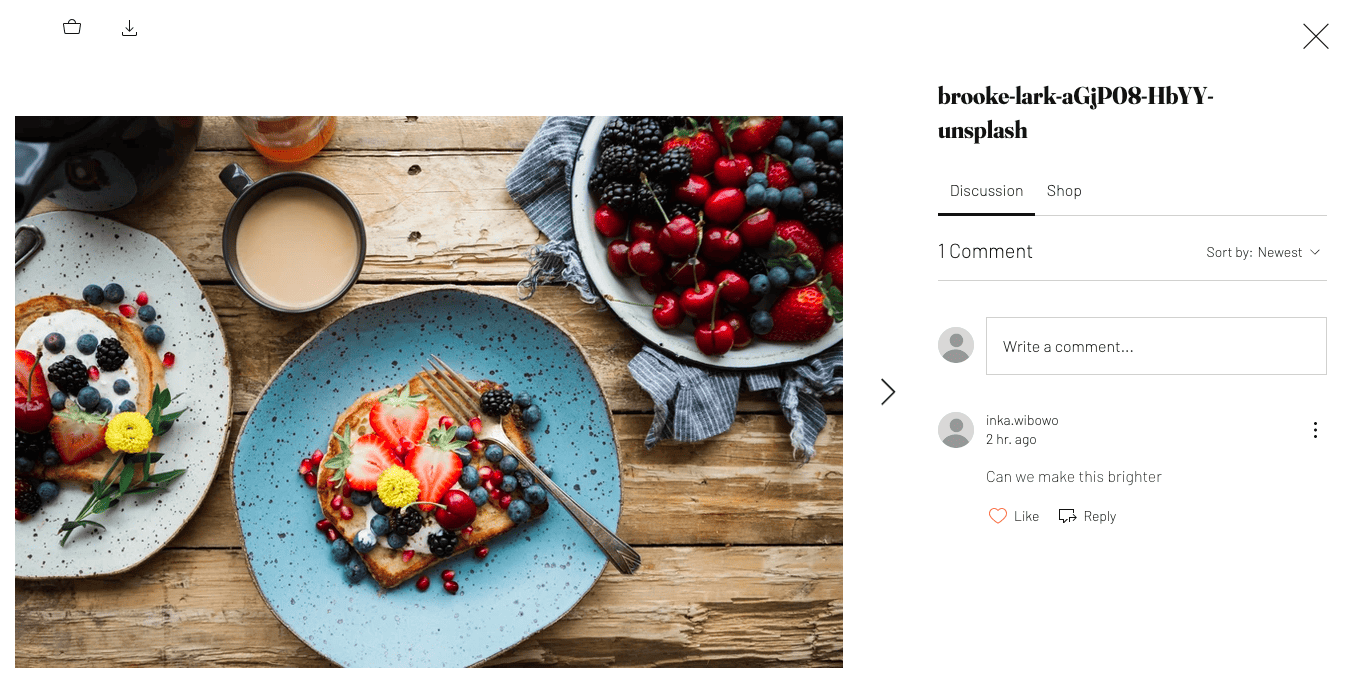
An example of a private album with client proofing features, using the Wix Photo Albums app
This makes it one of the best website builders for photographers looking to sell online. But, it’s not without its drawbacks, as we explore below.
Why Wix is great for photographers
- No other website builder offers the same range of free templates that Wix does. You have your pick of over 800 eye-catching templates, with around 50 specifically designed for photography websites.
- Wix’s drag-and-drop editor is also the most versatile that we’ve tested, letting you choose from a huge collection of content blocks, and place content wherever you like with pixel-perfect precision. (Learn more in our Wix tutorial.)
- The client proofing feature available with the Wix Photo Albums app is impressive, beating Squarespace’s more simplistic galleries feature. You can create private albums, allow clients to select and comment on photos, enable low-resolution or high-resolution downloads, sell digital artwork, and even sell prints via print-on-demand providers.
- Like Squarespace, Wix also offers an online appointment tool (Wix Bookings), letting customers book sessions with you through your website. In contrast to Squarespace, there’s no extra cost to use this – it’s included for free on all Wix Business plans
- Wix’s business and marketing tools are impressive. Thanks to the Wix Ascend business suite, you can optimize your website, run email marketing campaigns for your photography business, offer live chat support, manage invoices, and manage customer relationships, all from within Wix. Wix’s SEO options are top-notch, and its extensive App Market also allows you to add extra features to your site
Why Wix might not be the best website builder for you
- In our tests, we found Wix’s page loading speeds to be on the slow side. As Wix sites rely a lot on imagery, graphics, and apps, this can result in slower loading speeds for visitors, which could have a negative impact on search engine rankings. At times, Wix’s backend and editor can also be sluggish.
- While Wix’s templates look great, they’re not always mobile-friendly like they are with other website builders. Some editing may need to be done to the mobile version of the site to make it render correctly on mobile devices.
- If you ever want to refresh your site with a new design, you’ll come across a few challenges, as it’s not possible to switch templates with Wix. (While it’s technically not possible with Squarespace either, changing designs with Squarespace is much easier to do, thanks to how its templates are structured.) Instead, you’ll need to change everything manually.
- Storage limits are dependent on your plan – the more you pay, the more storage you get. If you’re using Wix to host your client galleries on the lowest plan (Light), you might hit the 2GB storage limit pretty quickly.
- Wix’s pricing is up there with Squarespace’s, with plans starting at $17. However, there is a free plan, which is fine to use for smaller sites that don’t need to accept bookings or payments. (A Wix ad will display and your site will use a Wix subdomain.)
Wix pricing
Wix offers a wide variety of plans, but the most popular are the following (prices shown are for yearly subscriptions):
- Free: $0. Most features are available but a Wix banner will display.
- Light: $24 / month. Wix ads are removed and you can use your own domain. 2GB of storage.
- Core: $36 / month. Sell online and take bookings. 50GB of storage.
- Business: $36 / month. Comes with the most advanced ecommerce features and unlimited storage.
When we would recommend Wix
Wix provides an all-in-one platform for building your photography site, sharing client galleries, and selling online. If you want the convenience of managing every aspect of your photography business in one place, then Wix offers great value for money.
> Read our in-depth Wix review
> Check out some examples of portfolio websites built with Wix
2. Squarespace – The website builder for creatives
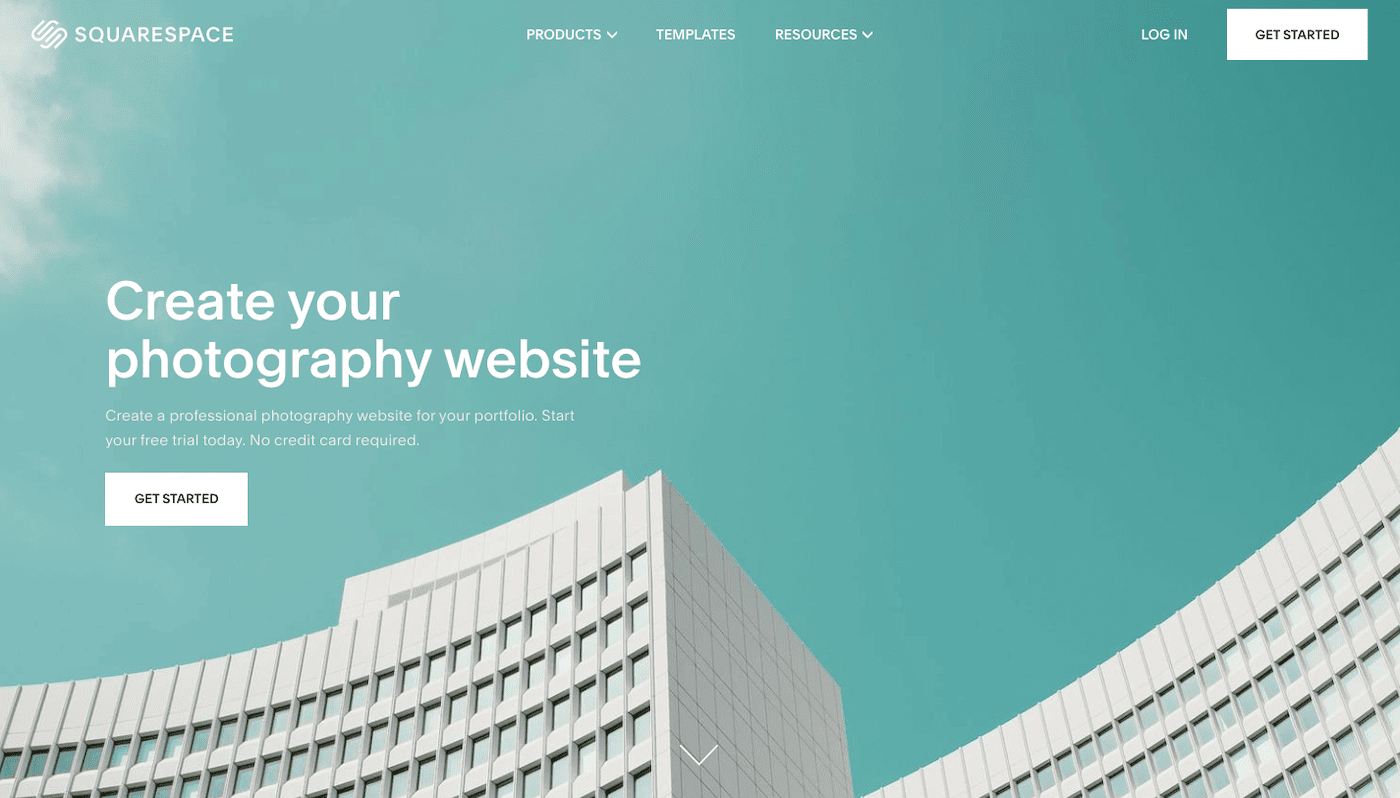
Coming in at #2 on our list of the best website builders for photographers is none other than Squarespace. You probably already know another photographer or artist who uses it (and sings its praises, we’re sure!).
With its minimalist aesthetic and visually-striking templates, Squarespace is popular with creative professionals who want their websites to stand out, without the need to code their designs from scratch.
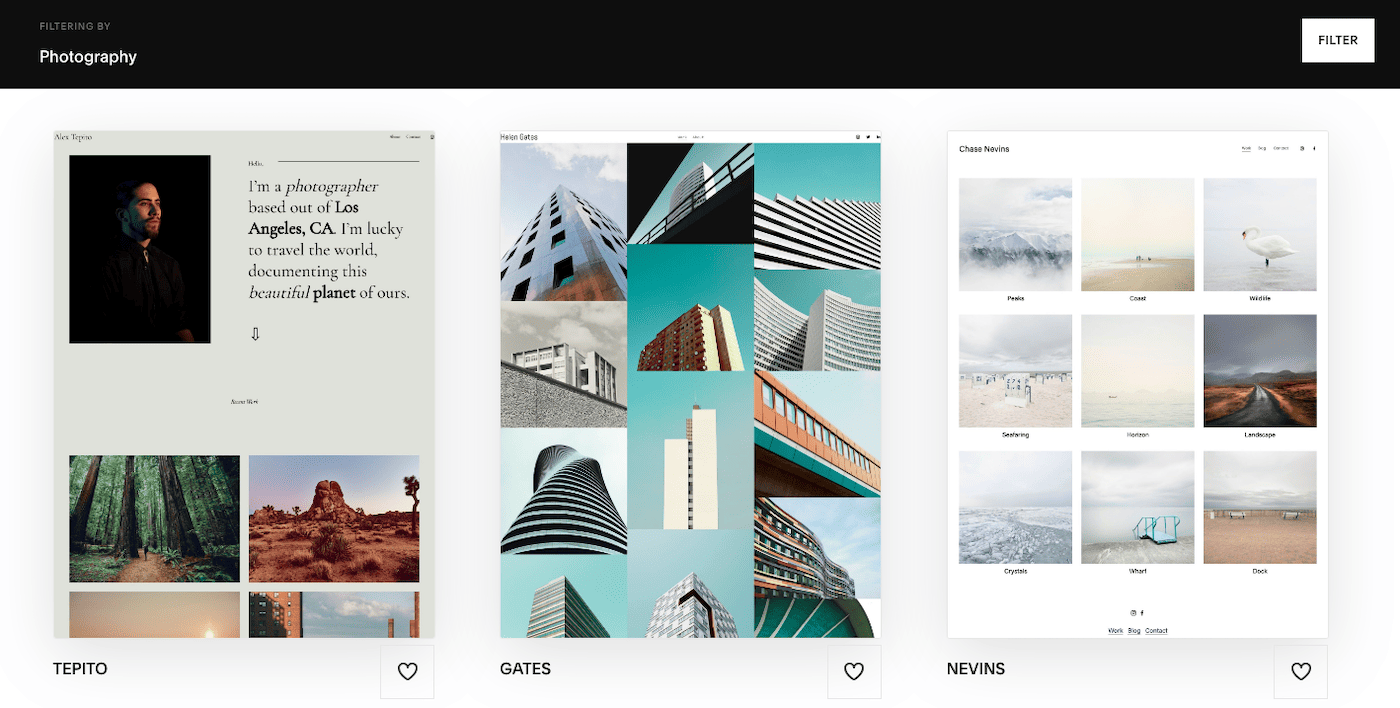
A selection of Squarespace’s photography templates
Squarespace’s grid-based editor lets photographers put their images front and center with very little effort, thanks to slideshows, lightboxes, and other image blocks. Portfolios and galleries can also be easily created, as we detail in our Squarespace tutorial.
Beneath its flashy exterior, there are also plenty of features to support a budding photography business, including an appointment booking add-on, content creation tools, and one of the most flexible ecommerce builders we’ve tried. Its SEO (search engine optimization) tools, which allow you to optimize your site for search, are also pretty advanced for a website builder.
Squarespace is also great because it has a membership area and features for selling courses. So if you’re thinking about sharing what you know, it’s easy to get started here.
Be prepared to pay a premium, though – Squarespace is not the cheapest website builder on our list. But what you save in time and additional costs may make the investment worth it.
Read on to learn more about Squarespace’s pros and cons.
Why Squarespace is great for photographers
- Squarespace is designed for creatives, and that’s reflected in their cutting-edge templates. If you’re trying to position yourself in the industry, there’s no other website builder that can help you do this better. Check out their selection of photography templates here.
- Squarespace’s excellent portfolio feature lets you beautifully showcase your work in a number of different layouts – something that’s not so intuitive to do with other website builders. This feature can also be extended to create password-protected client galleries.
- The Squarespace Commerce builder is excellent, giving you control over how your online store and product pages display. Integrations with print-on-demand apps like Printique and Printful let customers purchase prints directly from your site. It’s also possible to sell NFTs via Squarespace’s Unfold app. (Check out our full Squarespace ecommerce review here.)
- Squarespace places a huge emphasis on content and gives you the tools you need to create it – from its powerful blogging feature, to its social content creator (Unfold), and even its own video maker.
- You get unlimited storage on all Squarespace plans, so there’s no risk of you running out of space for storing your images and galleries.
Why Squarespace might not be the best website builder for you
- By nature, website builders are more restrictive than content management systems like WordPress (which is #3 on our list). While some flexibility is provided, you can only take customization so far. This might not be ideal if you want full design freedom.
- While you can create private galleries for clients, client-proofing features (e.g. the ability for clients to select or comment on images) are not supported, which might be limiting if you’re looking to monetize your work.
- Although we find Squarespace and its grid-based editor mostly easy to use, there are a few quirks to be aware of. It doesn’t autosave content, for example, and simple tasks often require a few too many clicks. You don’t get these issues with a website builder like Wix.
- It’s not the cheapest website builder, with plans ranging from $16 to $99. Add-ons such as the online booking tool and member areas are also charged extra. It doesn’t offer a free plan, either – only a 14-day trial. If you’re on a tight budget, check out Wix’s free plan, Pixpa, or Format, which are also on our list.
- Squarespace websites were also slow to load in our tests, which could have an impact on both user experience and Google search results
Squarespace pricing
Squarespace offers the following plans (prices shown are for yearly subscriptions):
- Personal: $16/month. For personal projects, portfolios and blogs. Includes password-protected pages. Unlimited storage.
- Business: $23/month. Adds marketing and basic ecommerce features.
- Basic Commerce: $39/month. Gives you extra ecommerce features, and 0% sales fees.
- Advanced Commerce: $99/month. Sell subscriptions and offer advanced shipping options.
Learn more about Squarespace pricing in our guide.
When we would recommend Squarespace
If aesthetics, ease of use, and getting online quickly are most important to you, then Squarespace is worth the investment. As a website builder that’s geared towards creatives, photographers will appreciate the stylish designs and the ease with which they can be customized. Bonus points for their excellent online store builder and appointment booking tool.
> Read our full Squarespace review
> See some examples of creative websites built with Squarespace
3. WordPress – The website builder with no limitations
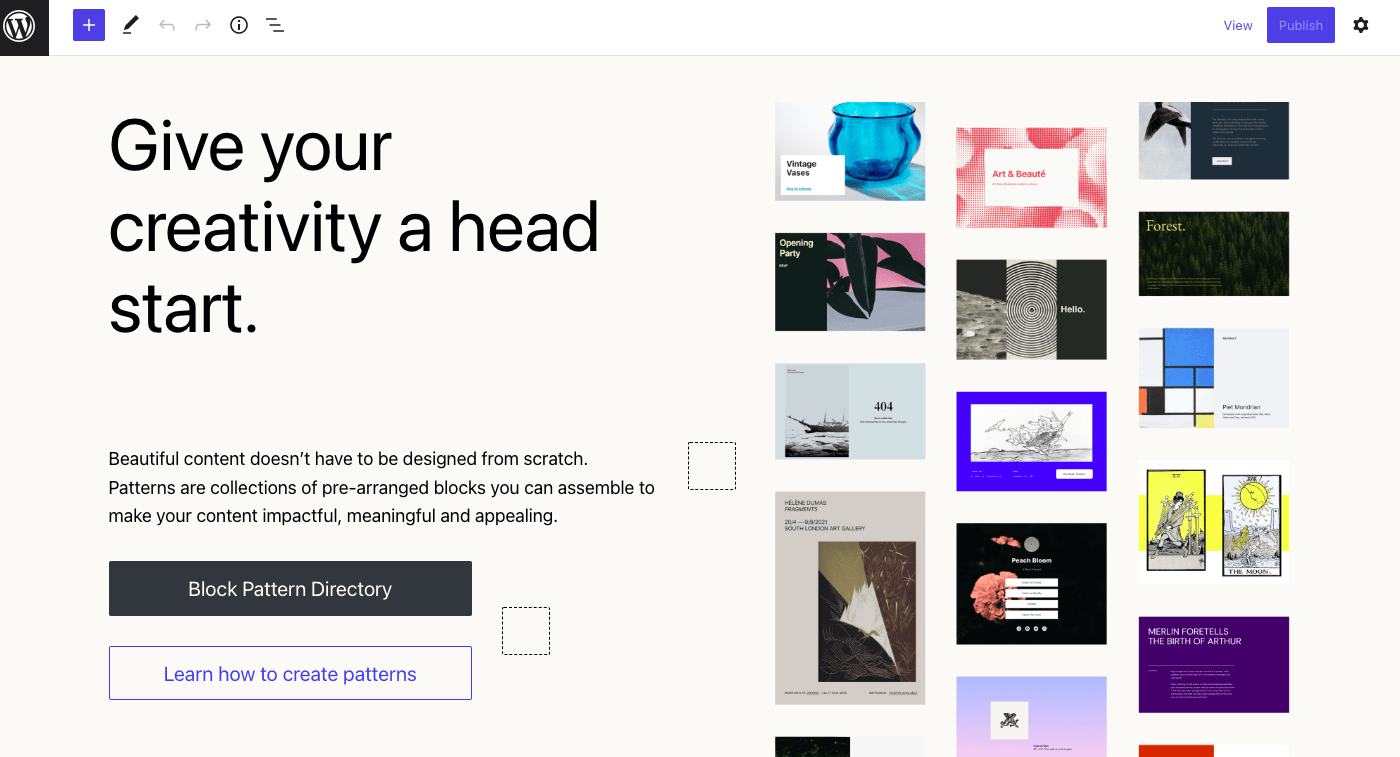
Over 40% of the web is powered by WordPress, so it’s no surprise that many photographers also choose this content management system for their building their own websites.
WordPress’s strength lies in its flexibility. With a wide range of customizable themes and plugins, you can create a WordPress site that looks unique, reflects your photography style, and supports all the features you need.
It’s also the best website builder for SEO – a huge advantage if you rely on local search traffic to gain new business. With the help of plugins like Yoast SEO, you can fully optimize every aspect of your site to maximize your chances of getting found online.
So what’s the downside? It’s not ideal for those who want a set-and-forget website, as it requires a lot of work upfront, plus ongoing maintenance (the help of a developer may even be required). Novice users may also find it less intuitive to use than website builders like Wix or Squarespace.
Read on to learn whether WordPress is right for your photography site.
Why WordPress is great for photographers
- Unmatched range of themes, including hundreds of photography designs on Themeforest, plus specialist theme providers. There’s also a huge range of plugins to help you deliver the best visual user experience, including galleries, sliders, image compression, and caching plugins.
- Excellent plugins to help you monetize your work, such as contact forms, appointment booking tools, and ecommerce add-ons (e.g. WooCommerce for selling both digital and print-on-demand products).
- WordPress offers advanced features that aren’t readily found in other website builders, extending the functionality of your site. For example, you can use it with portfolio-building tools like Semplice, or integrate client galleries with plugins like Picu. There are also plugins like Envira Gallery that can turn your site into a searchable stock photo site, and MemberPress, which can help you sell online photography courses to members.
- It’s hands-down the best website builder for getting found online. Built with SEO in mind, it supports your optimization efforts with great in-built tools and advanced SEO plugins.
- WordPress’s blogging solution is also recognized as an industry leader, with the ability to add media, support commenting, and complement your SEO strategy.
Why WordPress may not be the best website builder for you
- A lot of setup work is required. You need to organize hosting, select and customize a theme, connect a domain, and install plugins – from various providers – to get your site up and running. All-in-one website builders like Wix and Squarespace allow you to do all this in one place. (WordPress.com does something similar with its hosted plans, but it’s not the most cost-effective option – more on that in the ‘Pricing’ section below.)
- Requires more ongoing maintenance compared to other website builders. You’ll be in charge of plugin updates, security, and getting help in resolving technical issues.
- While it costs nothing to use the WordPress software, the cost of hosting, domain registration, purchasing a theme, and enabling plugins can all add up, and potentially result in significant yearly costs.
- Support can also be hard to come by, as WordPress doesn’t provide this directly (unless you’re a WordPress.com customer). You’ll need to rely mostly on self-support, with help available on knowledge bases, support forums, and from your hosting or plugin providers
WordPress pricing
The most popular WordPress.com plans are:
- Free: $0 / month. 1GB storage limit, WordPress.com ads displayed. No access to plugins.
- Premium: $8 / month. 13GB of storage and ads removed. Still no access to plugins, unfortunately, which means it’s only suitable for a basic portfolio site.
- Business: $25 / month. 200GB of storage and access to premium themes and plugins.
- Ecommerce: $45 / month. Same features as Business but lets you sell online with the WooCommerce plugin.
If you’d prefer to host your WordPress photography website with another provider (which is usually the more economical option), many offer WordPress hosting packages that typically start at around $5-10/month. Check out the cheapest WordPress hosting options here.
When we would recommend WordPress
WordPress makes the most sense if you want a photography site that’s fully your own – one that’s unique, flexible, and can grow to support your changing needs in the future. If you don’t mind rolling up your sleeves, WordPress can help you build a photography site exactly as you want it.
> Read our full WordPress guide
> Try WordPress for free with Dreamhost
> Learn about the differences between WordPress.com and WordPress.org here
WordPress User Stories
Barcelona-based wedding, family, and corporate photographer, Andrzej Witek, shares his experience with using WordPress for his photography website, and how he complements it with photo gallery platform Pictime.
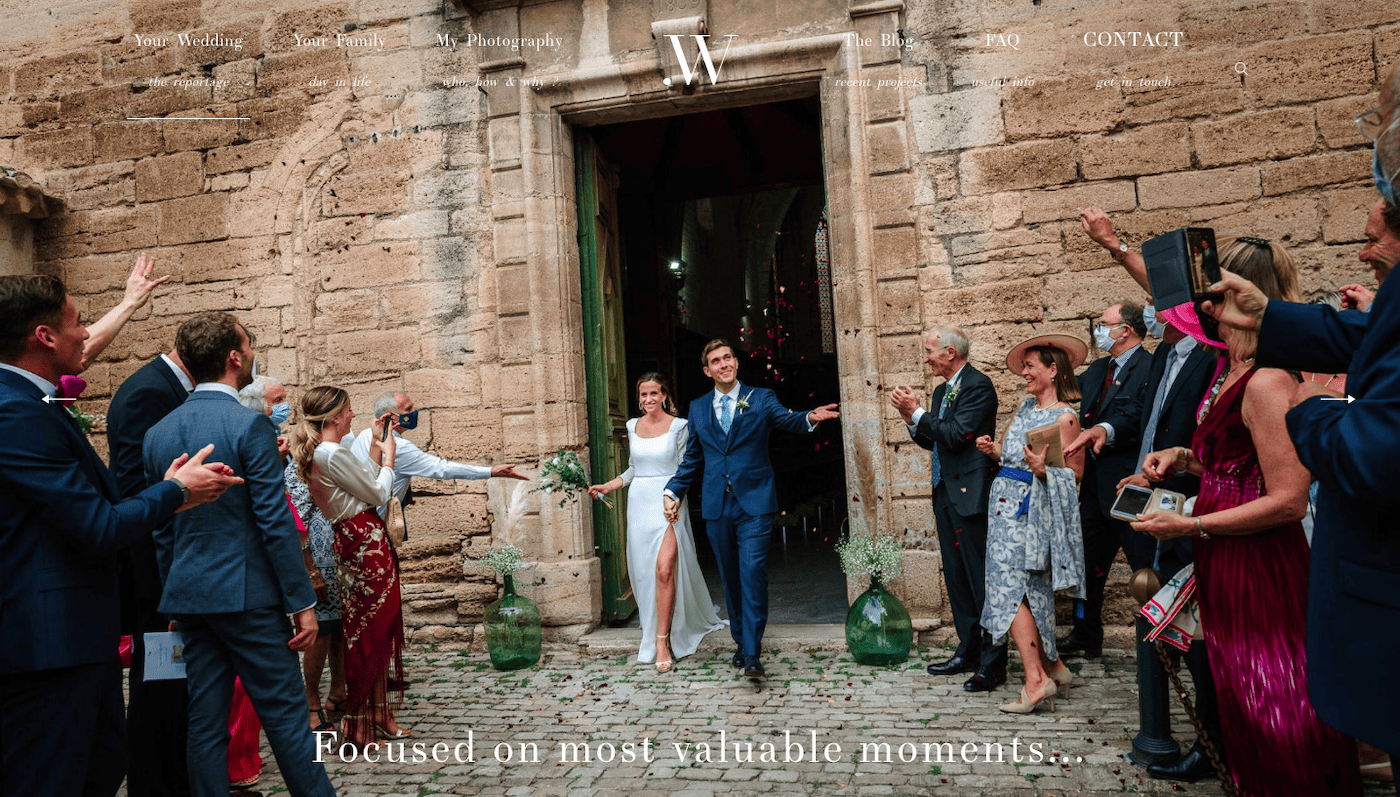
“I was looking for something simple. I like tech stuff, but I don’t have a lot of time for it. I also wanted something fairly open, so that if in the future, I wanted to connect a store and sell presets, for example, there would be no limitation.
At first, I looked at Squarespace, as it’s very popular but also simple. However, I found it to be limited, and the price was just so-so. I preferred to just pay for the hosting and forget about it, without bills coming in every month.
So I decided on WordPress. It works like a puzzle – you just put together the design and plugins you need. However, I didn’t like the free themes offered, so I found one I liked on a website called Flothemes (unfortunately they are now discontinuing their WordPress themes). They have really beautiful templates designed for photographers. And it was open enough to let me do whatever I wanted.
I installed their WordPress plugins and built the website myself. I think it took me three days – it was that easy.
On top of this, I have some SEO plugins, as well as a contact form that I put together, with custom fields that let the visitor describe their event and let me know how they found me.
In addition to a website, I also needed galleries to deliver the photos to my clients. And that’s when I found Pic-time (a separate service). What I like is that you can connect a shop, and customers can print albums directly from the gallery. I just order prints from different labs around the world and set all my prices on top of the margin from the lab. It doesn’t take me any effort.
I set up everything on my own, and for me, it simply works. I’m not super knowledgeable about the internet, but if I can do it, I think everybody can.
My advice would be to make it as simple as possible. I want to concentrate on photography, not on building a website. If something isn’t working, I can fix it very quickly without losing time. I can call somebody when I need help with the bigger stuff, but it’s important for me to be able to manage most of my website independently.”
4. Pixpa – The affordable, all-in-one photography website builder
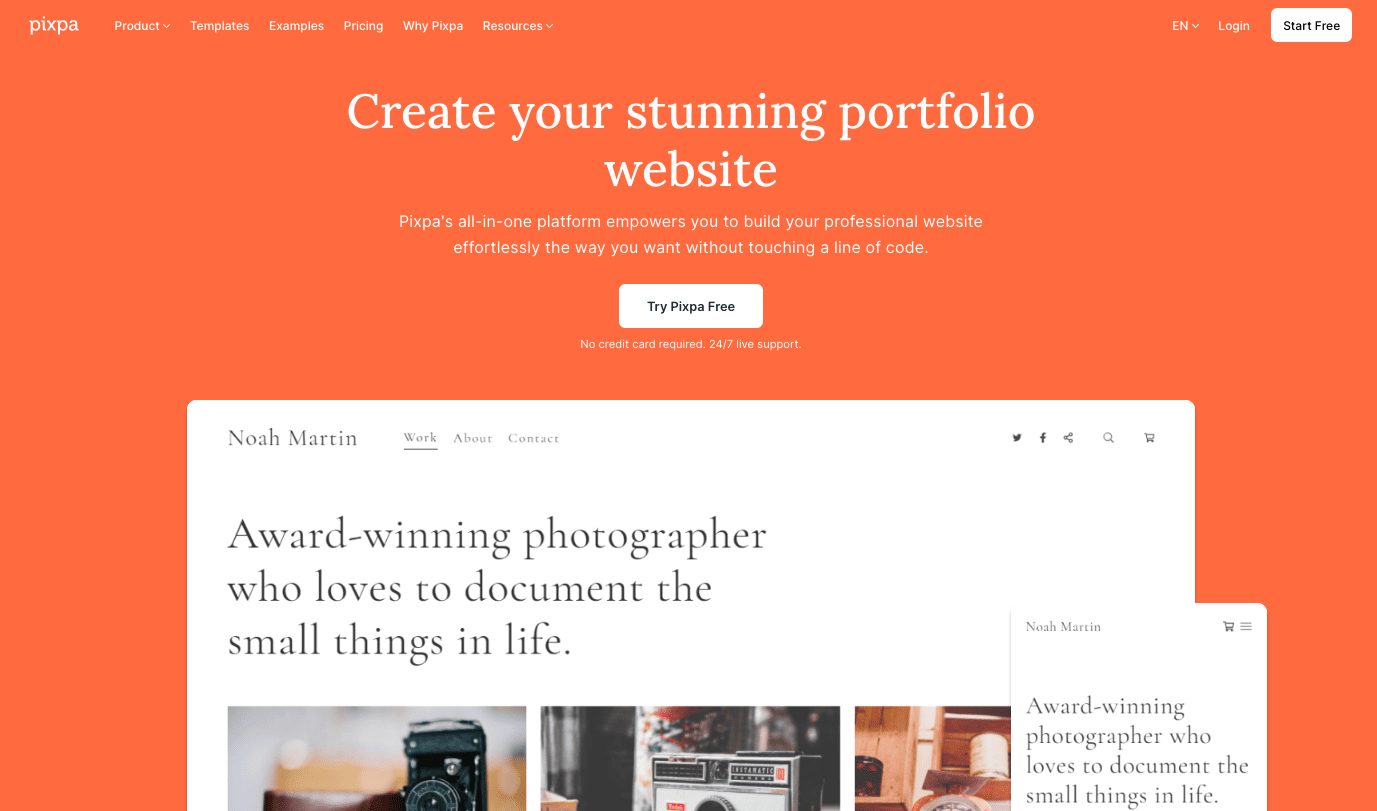
Unlike the website builders we’ve looked at so far, Pixpa specializes in portfolio websites, and in particular, the photography niche (which is great news for us!).
Its standout feature, though, is its pricing, which is a fraction of what its competitors charge.
That’s not to say its features are second-rate. In fact, Pixpa ticks all the boxes, offering over 120 modern templates, a flexible editor, portfolio pages, and top-notch client gallery and proofing features.
Pixpa is one of the few platforms that provides specialized photography features, along with the flexibility of the previous website builders we’ve discussed. It’s not hard to see that it takes a lot of inspiration from the #2 on our list, Squarespace. Many of the templates look very similar, and even the section-based editor is reminiscent of Squarespace’s.
So could this be the best website builder for your photography website? Let’s find out.
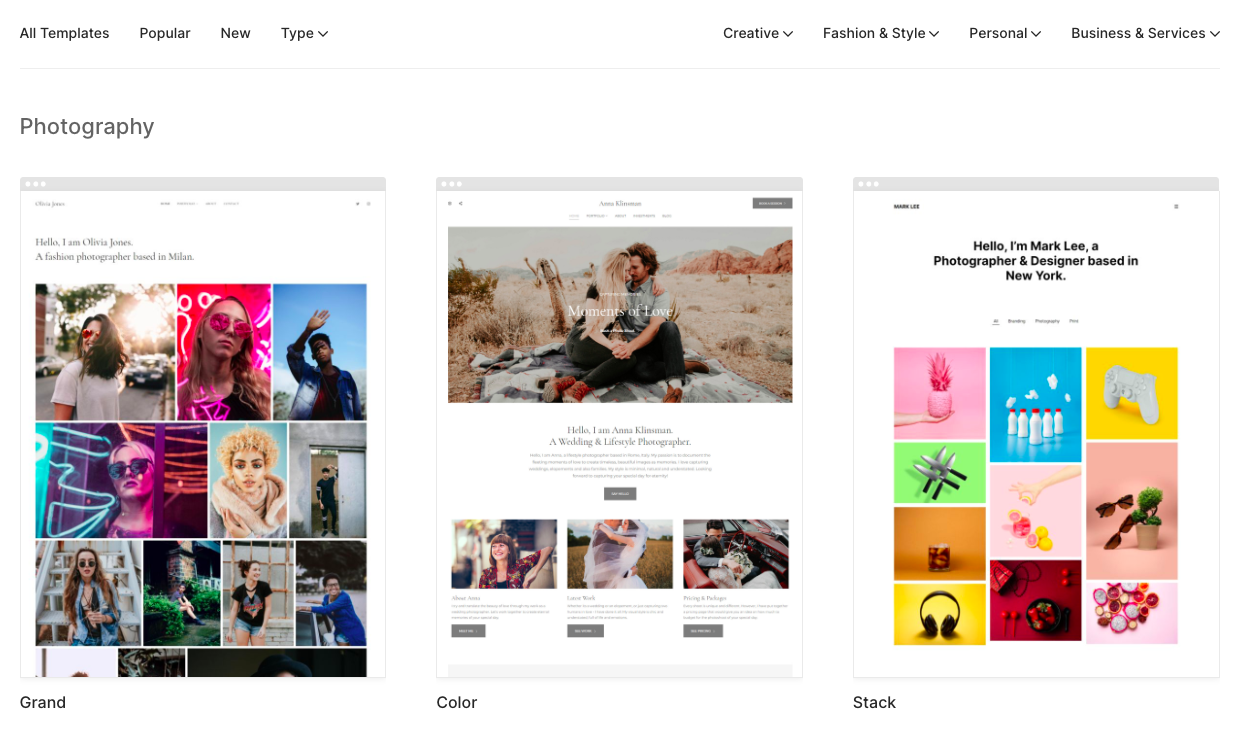
Pixpa’s website designs are similar to Squarespace’s, with over 120 templates available
Why Pixpa is great for photographers
- Pixpa is easy to use, with a smooth editing experience and intuitive backend. It provides a decent amount of flexibility in being able to design your pages and include the content you want (with pre-built sections for inserting galleries, testimonials, contact forms, and more). HTML and CSS editing are possible too.
- The client proofing features are among the best we’ve tested, allowing clients to view, comment, like, download, and purchase images (you can view all client activity for each gallery). It’s even possible to create a mobile gallery app for clients
- It offers advanced ecommerce options, including the ability to offer coupons, set tax/shipping rates, allow for customer and guest accounts, and send abandoned cart recovery emails. What’s more, the order fulfillment options are flexible, letting you choose between Pixpa’s print-on-demand partner (US-based WHCC), or a lab of your choice
- Pixpa provides some thoughtful marketing features to help you get the most out of your site. These include popups, announcement bars, email signup forms, a blog, and advanced SEO features
- Unlike the more rigid website builders lower down on our list, Pixpa gives you access to over 100 marketing, design, and ecommerce apps in Pixpa’s App Store, which can be easily enabled on your site.
- The pricing is extremely affordable, with plans starting at around $5/month. Further discounts are available for yearly or biennial plans. Pixpa doesn’t charge commissions on sales (as some of its competitors do)
Why Pixpa may not be the best website builder for you
- No free plan is available – only a 15-day trial to test out all the features.
- Although you get unlimited client galleries (and can upload as many web-sized images to these as you like), you are limited in the number of full-resolution images you can upload. With the absolute maximum being 100GB on the Advanced plan, it’s likely you’ll run out of space eventually, so you’ll need to store at least some of your original images elsewhere.
- The lower-level plans limit the number of pages and non-client galleries you can have on your site, so these are really only ideal for very small websites
- While it’s possible to sell services (such as a photo shoot), there’s no native appointment booking functionality. You can add a Google or BookingBug calendar, but it adds an extra step to the online booking process that’s not integrated into the purchase process.
Pixpa pricing
Pixpa offers the following plans (prices shown are for yearly subscriptions):
- Basic: $4.80 / month. For small portfolios only (no client galleries). Limit of 5 pages and 100 gallery images.
- Creator: $9.60 / month. Includes client galleries. 3GB of original image storage, and the ability to sell up to 5 products.
- Professional: $14.40 / month. 25GB of storage, unlimited pages, and marketing features.
- Advanced: $20 / month. Unlimited storage, and the ability to sell up to 1,000 products.
Tip: You can get an exclusive discount in your first year using the discount code websitetooltester10
When we would recommend Pixpa
Pixpa is a truly impressive tool, and we’d highly recommend it to photographers looking for an affordable, all-in-one platform to manage their site. While it may not allow for as much customization as the website builders we’ve previously discussed, it more than makes up for it with its excellent templates and easy-to-use editor. If you want a great-looking website with top features for selling your photography, it’s hard to beat Pixpa.
> Try Pixpa for free for 15 days
5. Format – The website builder for running a photography business
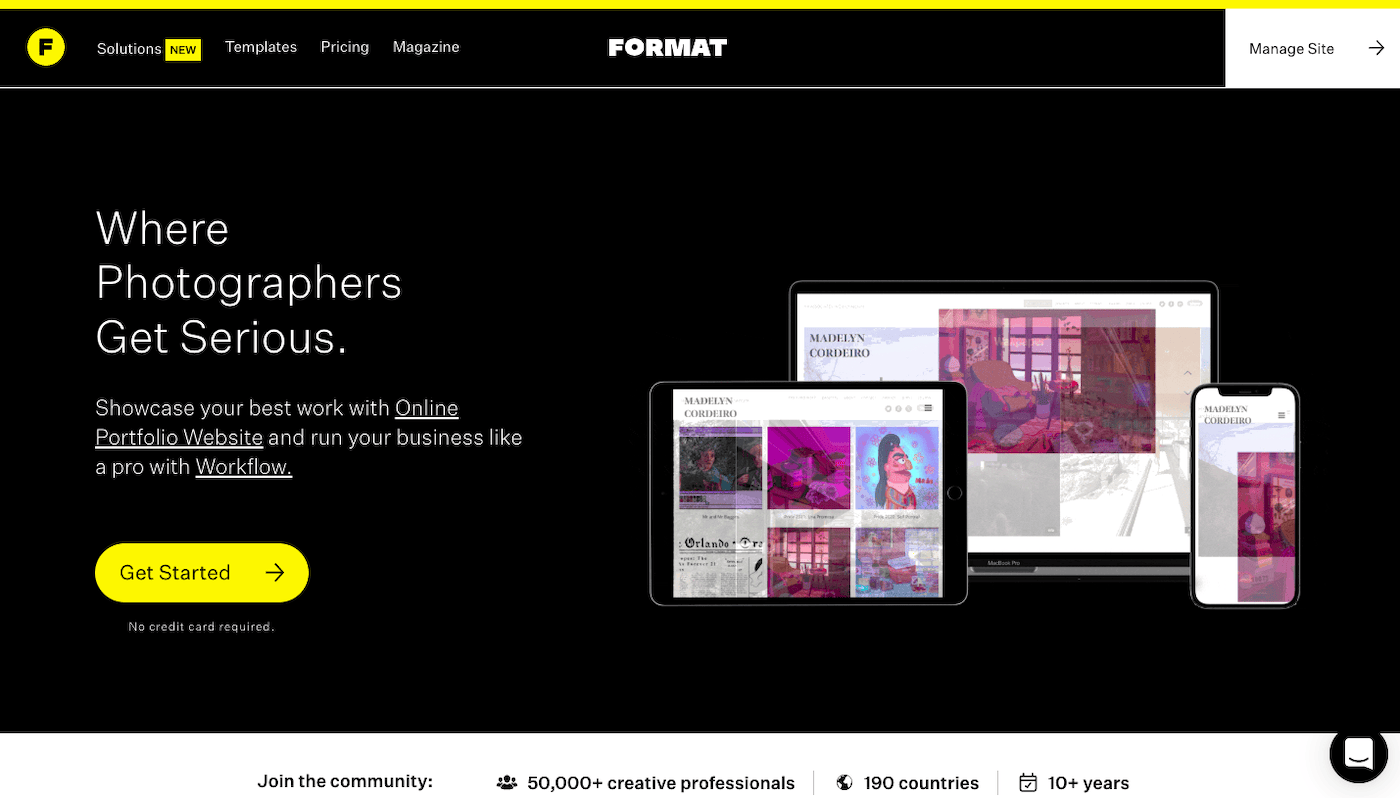
Format is another website builder that’s built exclusively for photographers and other creative professionals.
It expertly covers both the visual and business aspects of a photography website, offering photography-specific templates, client galleries, and ecommerce features. There are Lightroom and Capture One integrations, and you can also display portfolios, complete with watermarks and copyright protection.
The backend and editor are relatively simple, but that’s the beauty of it. The focus isn’t necessarily on creating the flashiest photography website, but one that carries out the most important tasks for running a successful photography business.
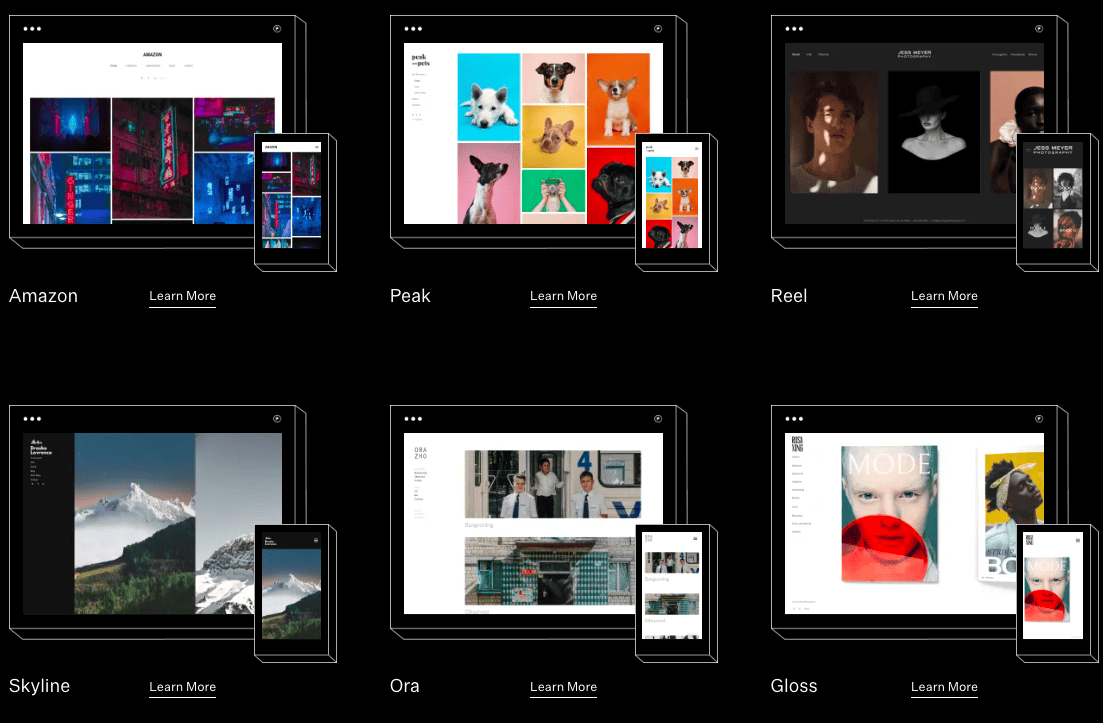
Some of the photography templates available with Format
There’s one main drawback, though. While Format’s client galleries are built for sharing digital artwork, there are no print-on-demand integrations for printing client photography.
Let’s check out Format’s pros and cons in more detail.
Why Format is great for photographers
- Format is features a good step-by-step setup guide. If you follow it to the end, you’ll have a clean, simple website that focuses on what’s important – getting your work in front of clients
- You get a selection of around 50 photography themes (out of a total of around 80). The designs are modern and mobile-responsive, allowing you to showcase your work in an eye-catching and user-friendly way. There’s also the option to edit HTML and CSS if you want to take your designs even further.
- The Workflow feature is ideal for sharing digital work, with features including branding, project management, file transfers, and even contracts.
- A feature that sets Format apart is its CRM (customer relationship manager), which lets you manage contact information, communications, and mailing lists in one place. From here, it’s also possible to share galleries and send files to your contacts.
- The ecommerce features for digital products are decent, letting you sell prints, packages, and presets in your own store. If that wasn’t enough, you also get access to Format’s Prints Marketplace where you can sell your artwork worldwide.
- Format offers some of the most affordable pricing out of all the website builders on our list, with plans starting at around $7/month. A free plan is also available for up to 10 client galleries. However, things start getting pricey when you start needing extra features (see ‘Pricing’ section below).
Why Format might not be the best website builder for you
- Customization options are limited compared to the above website builders. Rather than being able to drag and drop elements in, you can only add row-based sections. Some back and forth is also required between the editor and designs settings section to get pages ready for publishing. For more design control and a unique-looking website, we’d recommend Wix.
- While there are some good options for monetizing your work, it’s a shame that it’s not possible for clients to order personal prints through your site. Print-on-demand is only available for images sold through the Prints Marketplace (e.g. landscape, nature, creative photography). Note that commissions charged for selling on Marketplace range from 5-15%, depending on your plan.
- The contact form editor is basic. Although you can add custom fields, you can’t add dropdown lists or radio buttons (e.g. if you want the person contacting you to choose from a list of options).
- While it’s possible to sell services in your online store, there’s no calendar functionality to schedule appointments/photography sessions. This adds a couple of extra steps in the process of accepting bookings (e.g. additional phone calls or emails), which can be inconvenient for both you and the client
- The pricing options can be hard to get your head around. To build a website, you need a Portfolio plan, but you have a limit of 10 client galleries. To increase this limit, you need to add a Workflow plan, or opt for a Bundle that combines the two plans. The cost for this latter plan can range between $20-55, depending on discounts, so make sure you’re clear on what you’re signing up for.
Format Pricing
Format offers 7 different plans, which can be confusing. However, the most interesting are the following (prices displayed are for yearly subscriptions):
- Free: $0 / month. No website/portfolio features – client galleries only (10 max).
- Portfolio Basic: $7 / month. Allows for 15 pages and includes 10 client galleries.
- Portfolio Pro: $15 / month. 100GB of image storage and the ability to sell 3 products.
- Workflow Pro: $15 / month. Client galleries only (50 max).
- Bundle: $40 / month. Gives you access to both website and client galleries (250 max). 2TB of image storage and sell up to 1,000 products.
Why we recommend Format
Format is the most straightforward way to build a website that’s primed for showcasing your work, sharing client galleries, and delivering the final (digital) product. It’s a simple, affordable, and effective solution for photographers who are focused on the operational side of their business, and aren’t too concerned about having the most bold-looking design for their site.
> Try Format for free for 14 days
6. SmugMug – The website builder for selling your photography

Like Format, SmugMug specializes in photography websites, offering portfolio and client gallery features that make it one of the best website builders for photographers.
There are a few key differences, though. For one thing, SmugMug’s client gallery features are more complete, allowing for a wide range of proofing functions, and the ability for clients to purchase prints directly from the gallery. (There are also options to purchase digital images, wall art, and merchandise.)
You also get unlimited storage for photos with zero image compression, and can even add on extra storage for RAW files for around $3/month.
But with a basic editor and simplistic templates, you are compromising somewhat on your website’s design. So, let’s find out whether SmugMug could work for you.
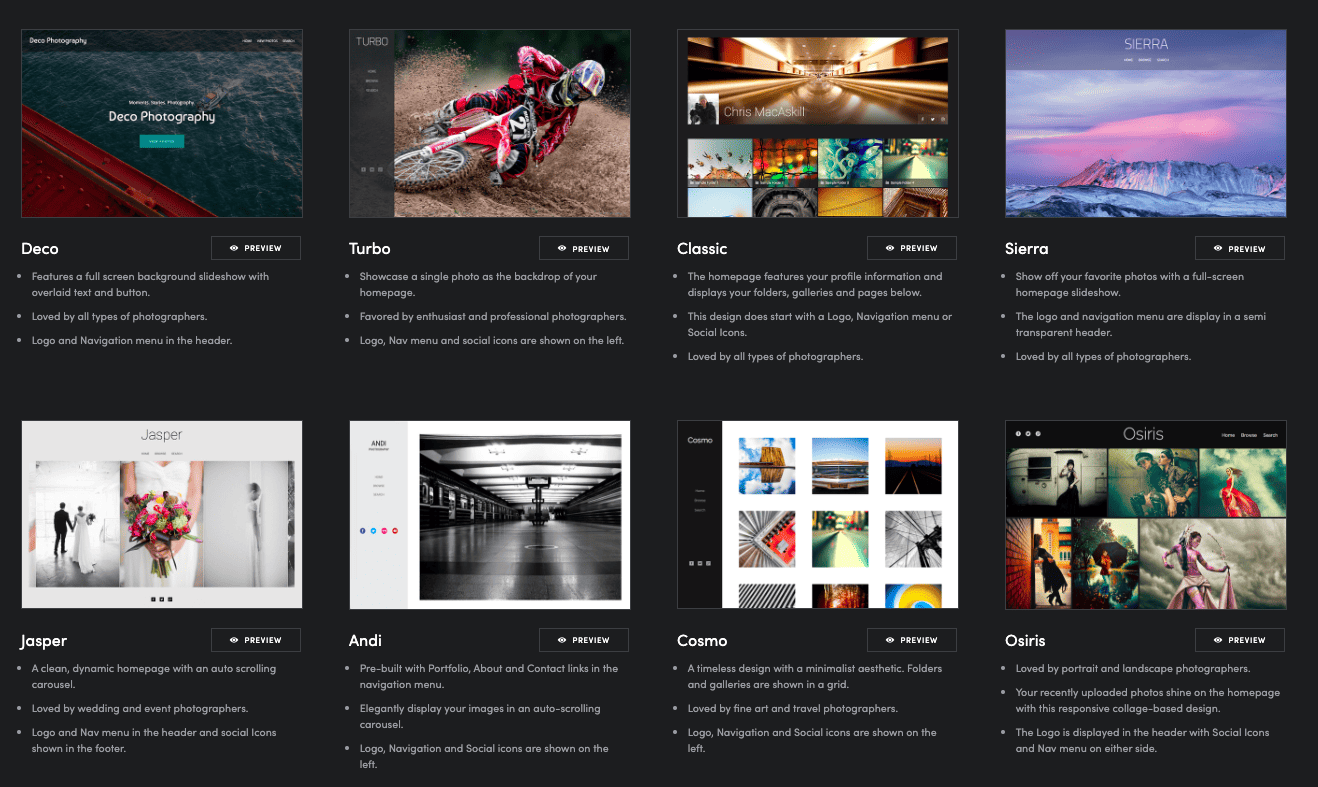
SmugMug’s small range of templates
Why SmugMug is great for photographers
- Getting images client-ready is easy with SmugMug’s exhaustive list of editing features. Apply effects, watermark images, crop, and add location data, all within the SmugMug editor.
- SmugMug’s client proofing features are second to none, letting clients share, comment, favorite, and, most importantly, purchase digital images and prints directly from their gallery. Unlimited storage ensures that your site can scale along with your growing business.
- In addition to letting clients order images, SmugMug offers advanced ecommerce features, including the ability to manage price lists, offer coupons, and even create packages.
- Smart Rules allow you to create dynamically-generated galleries, pulling in images based on keywords, dates, or locations. This makes it ideal for creating stock photo galleries and other collections.
Why SmugMug might not be the best website builder for you
- The website editor is very basic, and doesn’t allow for a huge amount of customization. The editing experience is also a little clunky, with editing panes that disappear and no undo/redo buttons. If you want to build something beyond a very simple site, you’ll struggle with SmugMug (although the HTML and CSS editing options can help you jazz things up a bit if you’re handy with code).
- SmugMug’s template range is limited to just a handful of templates. The designs are a bit lackluster and look outdated, so it’s not the best option if you’re looking to create a site with a standout design.
- Only a few printing labs seem to be available, and they’re based in the US and Scotland. If you’re outside of the US, UK, or Europe, it might not be the best option for selling physical prints.
- Adding a contact form is not very intuitive, and there are no options to edit form fields. However, there is an integration that lets you display a Wufoo form, and you can also embed other third-party forms using the HTML function
- While setting up a blog is theoretically possible, it takes a fair amount of manual work. Advanced blogging features such as commenting, categories, or tagging aren’t available. It’s therefore not ideal for those looking to use their blog to target search traffic.
- The pricing is on the higher end of the scale, with plans starting at $13/month. Client galleries and proofing are only available on the Pro plan, which is an eye-watering $42/month! SmugMug also charges a 15% commission on all sales. With that in mind, SmugMug really only makes sense for professional photographers who expect to generate high volumes of sales.
SmugMug Pricing
Below, we’ve included the monthly pricing as displayed on SmugMug’s website. Note that discounts of around 30% are available for annual subscriptions:
- Power: $13 / month. Unlimited storage, but limited ecommerce features. No client galleries or proofing.
- Portfolio: $28 / month. Includes sales and fulfillment tools and watermark protection.
- Pro: $ 42 / month. Includes client galleries and proofing, plus advanced ecommerce features (e.g. price lists, coupons).
Why we recommend SmugMug
Rather than focusing on knock-out visuals to attract new business, SmugMug’s expertise is in helping you deliver your work to existing clients, and in turning that work into a revenue stream. So, we’d recommend SmugMug to established photographers who have a steady stream of projects coming in, and are looking for a way to streamline their delivery, selling, and fulfillment processes.
> Try SmugMug for free for 14 days
Best website builder for photographers: Conclusion
With our roundup of the best photography website builders, we hope we’ve helped you find the right one for your needs! But in case you need a refresher, here are our top recommendations once again:
- Best website builder for a photography portfolio: Wix, Squarespace, Pixpa, Format
- Best website builder for client galleries and proofing: Wix, Pixpa, SmugMug
- Best website builder for standout designs: Squarespace, WordPress, Wix
- Best website builder for selling products: Wix, Pixpa, SmugMug
- Best website builder for online bookings: Squarespace, Wix, WordPress
- Best website builder for a small budget: Pixpa, Format
- Best free photography website builder: Wix, Format, WordPress.com
Also check out our guide on how to make a photography website if you need more help, as well as our article on how to make an online portfolio. For some extra inspiration, we also have an article where we share some great portfolio examples built with the above website builders.
Do you have any questions about building a photography website or portfolio? Let us know in the comments below!
We keep our content up to date
20 Sep 2023 - Flothemes discontinued
28 Aug 2023 - Updated information for Wix and Squarespace
16 Mar 2023 - Wix video tutorial
04 Jan 2023 - A few smaller updates
24 Nov 2022 - Added video on portfolio builders, update appointment booking information
THE BEHIND THE SCENES OF THIS BLOG
This article has been written and researched following a precise methodology.
Our methodology




